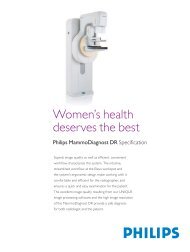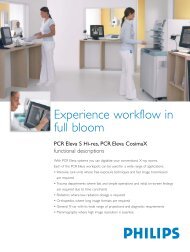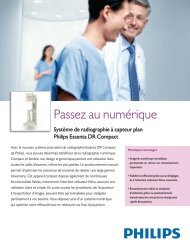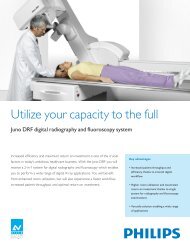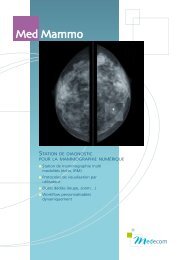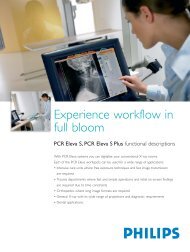Philips PCR Eleva Corado - Fas Radiologie
Philips PCR Eleva Corado - Fas Radiologie
Philips PCR Eleva Corado - Fas Radiologie
You also want an ePaper? Increase the reach of your titles
YUMPU automatically turns print PDFs into web optimized ePapers that Google loves.
Experience workflow in<br />
full bloom<br />
<strong>PCR</strong> <strong>Eleva</strong> <strong>Corado</strong> functional descriptions<br />
With <strong>PCR</strong> <strong>Eleva</strong> systems you can digitalize your conventional X-ray rooms.<br />
Each of the <strong>PCR</strong> <strong>Eleva</strong> workspots can be used for a wide range of applications:<br />
• Intensive care units where free exposure techniques and fast image transmission<br />
are required<br />
• Trauma departments where fast and simple operations and initial on-screen findings<br />
are required due to time constraints<br />
• Orthopedics where long image formats are required<br />
• General X-ray with its wide range of projections and diagnostic requirements.
<strong>PCR</strong> <strong>Eleva</strong><br />
<strong>PCR</strong> <strong>Eleva</strong><br />
<strong>PCR</strong> <strong>Eleva</strong> supports automated one-touch workflows.All stages,<br />
including image export to PACS or a printer, are totally streamlined<br />
and adapted to the way you work. In the <strong>Eleva</strong> concept, the<br />
information from the Radiology Information System (RIS) is used to<br />
automatically program the right <strong>Eleva</strong> pre-sets, such as for processing,<br />
printing and export, to ensure maximum efficiency.The processed<br />
image is quickly available. Image export and printing can be fully<br />
automized or performed on completion of the examination. Manual<br />
interaction is possible at any stage.Thanks to its intuitive touchscreen<br />
user interface, <strong>PCR</strong> <strong>Eleva</strong> supports easy navigation and smooth<br />
working procedures.This allows technologists to spend a maximum<br />
amount of time caring for patients.<br />
2<br />
<strong>PCR</strong> <strong>Eleva</strong> <strong>Corado</strong> system<br />
<strong>PCR</strong> <strong>Eleva</strong> systems offer:<br />
• RIS connection (Option)<br />
• DICOM functions:<br />
– DICOM WLM (Option)<br />
– DICOM MPPS (Option)<br />
– DICOM GSDF<br />
– DICOM Print (Option)<br />
– DICOM Image Export (Option)<br />
– DICOM Media (Option) 1<br />
• Touch or non-touch screen LCD monitor<br />
• UNIQUE image processing<br />
• <strong>Eleva</strong> concept – workflow customization<br />
• Viewing & Image manipulation<br />
• Move tool<br />
• Reject analysis (Option)<br />
• Reader sharing (Option)<br />
• Multiple <strong>Eleva</strong> workspots (Option)<br />
• Automatic image stitching (Option) 1<br />
• iSite integration (Option) 1<br />
• Vequion competence<br />
• Special application cassettes (Accessories)<br />
• Integrated virus scanner<br />
• Extended security with mShield (Option)<br />
• HIPAA compliance<br />
• Quality Control Kit for Digital Radiography (Option).<br />
<strong>PCR</strong> <strong>Eleva</strong> systems offer complete integration into your hospital<br />
network with a RIS interface and DICOM communication.<br />
<strong>PCR</strong> <strong>Eleva</strong> systems can be used with all existing X-ray equipment, no<br />
modification is necessary.The imaging plate cassettes are used in the<br />
same way as conventional film-screen cassettes.<br />
Patient list<br />
RIS connection (Option)<br />
<strong>PCR</strong> <strong>Eleva</strong> can be connected to a RIS for automatic<br />
updating of the patient worklist. <strong>PCR</strong> <strong>Eleva</strong> supports RIS<br />
connection through either DICOM Worklist Management<br />
(WLM) or an FTP interface.The examination information<br />
from the RIS is used by the <strong>Eleva</strong> concept to automatically<br />
program the right <strong>Eleva</strong> pre-sets for image<br />
processing, printing and export.<br />
1 with release 1.1
Main features<br />
DICOM functions<br />
Please refer to the separate DICOM Conformance<br />
Statement for detailed information.<br />
DICOM WLM (Worklist Management)<br />
(Option)<br />
DICOM WLM supports communication<br />
between the RIS and the <strong>PCR</strong> <strong>Eleva</strong> modality,<br />
whereby the <strong>PCR</strong> <strong>Eleva</strong> automatically<br />
retrieves the worklist from the RIS.The<br />
worklist query can be performed on a<br />
“broad” (generic) or “specific” (patient<br />
oriented) basis.<br />
You can carry out the worklist query<br />
automatically in the background (“broad”) or<br />
interactively, on operator request (“broad”<br />
and “specific”).<br />
DICOM MPPS (Modality Performed<br />
Procedure Step) (Option)<br />
DICOM MPPS serves to send examination<br />
data back from the <strong>PCR</strong> <strong>Eleva</strong> system to the<br />
RIS. In this way, the RIS server and the PACS<br />
are informed about start, end and examination<br />
content.The information sent back<br />
relates to the corresponding entries in the<br />
worklist:<br />
• Patient and procedure data<br />
• Number of exported DICOM images<br />
• User comment on the Performed<br />
Procedure Step.<br />
DICOM Grayscale Standard Display Function<br />
(GSDF)<br />
With DICOM GSDF, <strong>PCR</strong> <strong>Eleva</strong> facilitates<br />
consistent high-quality image display on both<br />
print-outs and PACS viewing monitors when<br />
exporting to DICOM imagers and PACS<br />
systems supporting the same function.<br />
<strong>PCR</strong> <strong>Eleva</strong> displays images according to the<br />
GSDF, thus providing optimum consistency<br />
between quality control and reading<br />
situations.<br />
DICOM Print (Option)<br />
DICOM Print allows for manual and<br />
automatic printing directly from the <strong>Eleva</strong><br />
workspot. It enables the user to transfer<br />
images to a networked DICOM imager with<br />
a choice of different printing modes:<br />
• Autoprint:<br />
Automatic image printing on predefined film<br />
layouts according to the examination<br />
• Manual print:<br />
Manual image placement on predefined film<br />
layouts or image placement on free layout<br />
composition.<br />
The predefined film layouts can be changed<br />
and extended by the advanced user to meet<br />
individual needs.<br />
DICOM Image Export (Option)<br />
DICOM Image Export consists of two<br />
services:<br />
• The DICOM Store service sends DICOM<br />
images to PACS or any other DICOM<br />
destination.<br />
• The DICOM Storage Commit service<br />
enables the storage destination to inform<br />
<strong>PCR</strong> <strong>Eleva</strong> when images have been securely<br />
stored.This trigger is used by <strong>PCR</strong> <strong>Eleva</strong> to<br />
allow related images to be deleted.<br />
Images can be stored manually and<br />
automatically within the <strong>Eleva</strong> concept.<br />
Automatic export can be configured on an<br />
examination base to up to four destinations<br />
in parallel.<br />
Touch or non-touch screen LCD<br />
monitor<br />
You have the choice between two different<br />
monitors:<br />
• 17" LCD color touch screen monitor<br />
• 17" LCD color monitor (non-touch).<br />
The convenient touch screen usage optimally<br />
supports the workflow with <strong>PCR</strong> <strong>Eleva</strong>'s<br />
clear and powerful user interface, allowing<br />
maximum efficiency.<br />
Both the touch and the non-touch screen<br />
monitors can be wall-mounted (option),<br />
therefore turning the <strong>PCR</strong> <strong>Eleva</strong> workspot<br />
into an optimal solution for space critical<br />
locations. <strong>PCR</strong> <strong>Eleva</strong> supports a virtual touch<br />
keyboard on the screen, so no keyboard<br />
device is necessary.<br />
LCD color touch screen monitor<br />
3
Main features<br />
UNIQUE image processing<br />
<strong>PCR</strong> <strong>Eleva</strong> includes UNIQUE <strong>Philips</strong> advanced<br />
multi-resolution image processing software as<br />
standard. UNIQUE combines outstanding<br />
image dynamics with superb detail contrast.<br />
The processed images are instantly available<br />
at the <strong>Eleva</strong> workspot with a level of quality<br />
so similar to DR technology that it is hard to<br />
tell them apart. UNIQUE image processing<br />
software:<br />
• Harmonizes contrast,<br />
• Enhances weak details to achieve superb<br />
detail accuracy in all areas,<br />
• Eliminates virtually all processing artifacts,<br />
• Permits a visually uniform impression for<br />
<strong>PCR</strong> <strong>Eleva</strong> and DigitalDiagnost exposures,<br />
• Achieves consistently high image quality.<br />
UNIQUE image processing is ideal for both<br />
softcopy viewing and film printing. It offers a<br />
significant improvement in image quality while<br />
preserving the images' natural appearance.<br />
Of course, all parameters can easily be<br />
customized to suit individual preferences.<br />
Please also see our additional information<br />
material about UNIQUE.<br />
<strong>Eleva</strong> concept – workflow<br />
customization<br />
<strong>PCR</strong> <strong>Eleva</strong> adapts to the way you work.<br />
The <strong>Eleva</strong> concept simplifies and customizes<br />
your workflow according to your specific<br />
requirements.<br />
The examination information from the RIS is<br />
used to automatically program the right <strong>Eleva</strong><br />
pre-sets, such as for exam-specific processing,<br />
printing and image export.All these pre-sets<br />
can be individually customized to your<br />
department's requirements. Plus, the<br />
automization of the workflow procedures<br />
(auto shuttering, auto rotation, auto mirror,<br />
auto export, auto stitching, auto print)<br />
facilitates “one-touch workflows” for<br />
maximized efficiency.<br />
Viewing and image manipulation<br />
After the plate readout, the UNIQUE<br />
processed image is available within seconds<br />
for verification of on-screen findings.The<br />
operator can, in addition, use a wide range of<br />
parameters to further enhance the image:<br />
• Contrast / Brightness<br />
• Rotation / Mirror<br />
• Annotation (L/R, user defined, free text)<br />
• Shutters<br />
• Zoom and pan 1<br />
• Segments and angles measurements 1<br />
• Re-processing.<br />
Move tool<br />
If the technologist mixes up cassettes or<br />
views when linking cassettes to a patient at<br />
the <strong>Eleva</strong> workspot, this can result in an<br />
image being associated to a wrong patient or<br />
view.The technologist can easily correct the<br />
error by using the clip board function of the<br />
move image tool.<br />
In this way, patient X' Chest AP which is in<br />
reality his Chest lateral can be corrected,<br />
together with all image information, allowing<br />
it to be archived or printed with the correct<br />
patient and image information as well as the<br />
optimal image processing.<br />
Reject analysis (Option)<br />
This convenient image statistic tool provides<br />
the advanced user with the functionality to<br />
analyze rejected images in terms of operators<br />
and rejection reasons. It also serves to<br />
monitor and analyze general parameters.The<br />
data files can be downloaded for further use<br />
or archiving on a standard PC.<br />
It supports both the quality standards of the<br />
department and teaching situations perfectly.<br />
1 with release 1.1<br />
Multiple <strong>Eleva</strong> workspots
Reader sharing (Option)<br />
Reader sharing means that one <strong>PCR</strong> <strong>Eleva</strong><br />
reader is connected with other <strong>PCR</strong> <strong>Eleva</strong><br />
readers in a network for increased workflow<br />
flexibility.The operator can use any free<br />
reader slot in the network and the image<br />
which has been read out will be displayed at<br />
the <strong>Eleva</strong> workspot where the cassette was<br />
initially barcoded. Different <strong>PCR</strong> <strong>Eleva</strong><br />
readers (single- or multi-slot) can be shared<br />
in such a network.This kind of multi-reader<br />
setup provides an excellent backup solution.<br />
Multiple <strong>Eleva</strong> workspots (Option)<br />
One <strong>PCR</strong> <strong>Eleva</strong> reader can connect up to 8<br />
<strong>PCR</strong> <strong>Eleva</strong> workspots.The workspots can be<br />
placed in the department as required for an<br />
optimized workflow, e.g. in each X-ray room.<br />
Each workspot will work independently of<br />
the others, providing the technologist with all<br />
the functionality necessary for performing the<br />
entire examination.<br />
Automatic image stitching (Option) 1<br />
This advanced option is needed when using<br />
the long orthopedy cassettes. Using such<br />
cassettes, with one exposure, the complete<br />
required anatomy for long leg or full spine<br />
images is captured on 2 or 3 (dependent on<br />
cassette size) imaging plates. <strong>PCR</strong> <strong>Eleva</strong><br />
optimizes the workflow by automatically and<br />
quickly stitching together the images in the<br />
background after cassette reading.<br />
The resulting single image is quickly available<br />
for review, validation, distance/angle<br />
measurements, export or print.This option<br />
includes also the Cobb’s angle measurement.<br />
1 with release 1.1<br />
DICOM Media (Option) 1<br />
This option offers the possibility of writing<br />
CDs directly on the <strong>PCR</strong> <strong>Eleva</strong> workspots.<br />
Each burned CD complies with the DICOM<br />
Media Interchange format and includes a<br />
stand-alone <strong>Philips</strong> DICOM viewer to review<br />
the CD content on any standard PC.<br />
iSite integration (Option) 1<br />
This option allows access to <strong>Philips</strong>' iSite<br />
PACS directly on <strong>PCR</strong> <strong>Eleva</strong> workspots.<br />
This is particularly interesting in terms of<br />
workflow improvement as <strong>PCR</strong> <strong>Eleva</strong><br />
workspot users can use this to review<br />
previous examinations of a patient, or even<br />
display images of other modalities, without<br />
leaving the <strong>PCR</strong> <strong>Eleva</strong> workspot.<br />
Vequion competent<br />
<strong>PCR</strong> <strong>Eleva</strong> systems are Vequion-competent.<br />
Vequion is the <strong>Philips</strong>' strategy for next<br />
generation healthcare products, solutions and<br />
professional services.Vequion offers users a<br />
customized information management<br />
experience that aids confident and faster<br />
diagnosis and makes work more gratifying.<br />
Vequion-competent systems are<br />
customizable, they allow a fluid flow of<br />
information with seamless integration into<br />
the hospital network.They are based on open<br />
and standard technology and are future-safe.
Special application cassettes<br />
(Accessories)<br />
<strong>Philips</strong> offers a wide range of cassettes for<br />
general radiography and special applications<br />
like orthopedics and pediatrics. <strong>PCR</strong> <strong>Eleva</strong><br />
offers long cassettes from 24 cm x 57 cm<br />
(10" x 23") to 35 cm x 124 cm (14" x 43").<br />
All long cassettes contain two or three<br />
imaging plates and can be read directly by the<br />
<strong>PCR</strong> cassette reader.The global long image is<br />
automatically reconstructed using the<br />
automatic image stitching option.<br />
Integrated virus scanner<br />
Each <strong>PCR</strong> <strong>Eleva</strong> workspot includes McAfee<br />
Antivirus software.This program can be<br />
activated to permanently check for infections<br />
in the background and immediately notifying<br />
the user in case of attack.Virus definition<br />
updates are performed through the service<br />
channel.<br />
For maximum IT security, active protection<br />
using <strong>Philips</strong>’ optional mShield dedicated<br />
firewall is recommended.<br />
Extended security with mShield<br />
(Option)<br />
<strong>Philips</strong>' mShield is part of an overall strategy<br />
to safeguard the data integrity of medical<br />
information systems. It protects <strong>Philips</strong>'<br />
modalities from malicious attacks.<br />
By restricting traffic to authorized devices<br />
only, mShield acts to prevent malicious<br />
activity directed from the modality to<br />
unrelated devices on your hospital network.<br />
Network communication can be restricted to<br />
DICOM communication and remote service<br />
only.Thereby, the channels required by<br />
hackers to spread attacks or viruses become<br />
unavailable. Please also see our additional<br />
information material about mShield.<br />
HIPAA compliance<br />
<strong>Philips</strong> has taken many steps to enhance the<br />
security of medical devices in response to<br />
customer requests.When used properly, the<br />
security features of <strong>Philips</strong>' products make it<br />
easier for users to meet their obligations to<br />
ensure the confidentiality, integrity, and<br />
availability of patients' health information.<br />
In light of the increased focus on medical<br />
device security and compliance with the<br />
HIPAA Security Rule in the USA, the Health<br />
Information Management Systems Society<br />
(HIMSS: www.himss.org) has created a<br />
standard “Manufacturer Disclosure Statement<br />
for Medical Device Security” (MDS2).<br />
The aim of the MDS2 is to supply healthcare<br />
providers with important information that<br />
can assist them in assessing the vulnerabilities<br />
and risks associated with electronic<br />
Protected Health Information (ePHI) which is<br />
created, transmitted or maintained by medical<br />
devices.<br />
<strong>Philips</strong> publishes these MDS2 forms for most<br />
supported <strong>Philips</strong> Medical Systems products<br />
including the <strong>PCR</strong> <strong>Eleva</strong> Workspot.<br />
<strong>Philips</strong> MDS2 forms are available to<br />
customers and potential customers on the<br />
Internet at:<br />
www.medical.philips.com/us/productsecurity/mds2<br />
Orthopedic cassettes<br />
Some relevant <strong>PCR</strong> <strong>Eleva</strong><br />
workspot security features<br />
include:<br />
• Unique user identification &<br />
authentication mechanism (password<br />
protected access)<br />
• Audit message generation for<br />
tracking access to patients' protected<br />
health information<br />
• Operating system “hardening”<br />
• Integrated antivirus software<br />
• Hardware firewall (optional).<br />
Quality Control Kit for Digital<br />
Radiography (Option)<br />
This kit provides the tools you need to<br />
control the quality of your digital X-ray<br />
system. Possible controls include dynamic<br />
range, contrast, homogeneity of the<br />
exposure and spatial resolution of the<br />
X-ray system.The kit is composed of a test<br />
phantom, an aluminium attenuator,<br />
a support to mount on a chest unit and the<br />
documentation, all in a convenient carrying<br />
case.
<strong>PCR</strong> <strong>Eleva</strong> <strong>Corado</strong><br />
7<br />
<strong>PCR</strong> <strong>Eleva</strong> <strong>Corado</strong><br />
The <strong>PCR</strong> <strong>Eleva</strong> <strong>Corado</strong> reader has a cassette<br />
feeding unit for 4 cassettes.This allows high<br />
throughput (up to 165 plates/hour) and<br />
smooth workflow, when centrally placed in<br />
the radiology department. It offers a high<br />
resolution with 100 µm pixel size.<br />
For more information about the reader,<br />
please refer to the table on page 12.<br />
Functionality<br />
Image plate reading process<br />
After inserting the cassette into the reader,<br />
the barcode of the imaging plate is read by<br />
the internal barcode reader.This connects the<br />
clinical image from the plate to the patient,<br />
examination and specific view.<br />
The reader removes the exposed plate from<br />
the cassette and the reading process starts<br />
according to the examination parameters.<br />
After that, the plate will be erased in order<br />
to ensure that no residual information<br />
remains on the imaging plate.As soon as the<br />
cassette is reloaded and released, the reading<br />
procedure is finished.<br />
The cassettes have standard dimensions and<br />
can be used in any conventional X-ray system<br />
instead of the current film-screen cassettes.<br />
Loading and releasing of the cassette inside<br />
the reader is done automatically.<br />
During readout, the image is shown in parallel<br />
on the <strong>Eleva</strong> workspot for quick image<br />
display.
Possible department setup<br />
8<br />
Central reader setup<br />
For this setup we recommend using a multi-slot reader, to<br />
facilitate good workflow.You can connect several <strong>Eleva</strong><br />
workspots (up to 8) to one <strong>PCR</strong> <strong>Eleva</strong> reader.The clinical<br />
image will show up at the <strong>Eleva</strong> workspot where the<br />
examination has been initiated, which means where the<br />
cassette has been barcoded. <strong>PCR</strong> <strong>Eleva</strong> <strong>Corado</strong> has a<br />
throughput of up to 165 plates per hour and facilitates<br />
smooth operation and workflow when centrally placed in<br />
the radiology department.The <strong>Eleva</strong> workspots can be<br />
placed throughout the department to optimally support the<br />
desired workflow.
Generator<br />
Bucky table<br />
<strong>Eleva</strong><br />
workspot<br />
<strong>PCR</strong> <strong>Eleva</strong> <strong>Corado</strong>, central reader setup<br />
Tube<br />
<strong>Eleva</strong><br />
workspot<br />
Generator<br />
<strong>Eleva</strong><br />
workspot<br />
Reader:<br />
<strong>PCR</strong> <strong>Eleva</strong> <strong>Corado</strong><br />
Cluster of several <strong>PCR</strong> <strong>Eleva</strong> systems<br />
You can cluster your <strong>PCR</strong> readers so that they can be<br />
used from each workspot in the cluster.This functionality<br />
is called “Reader sharing”.The clinical images will be<br />
shown on the <strong>Eleva</strong> workspot which initiates the<br />
examination and all other readers can serve as alternate<br />
readouts or backups, giving more flexibility, maximum<br />
efficiency and security.<br />
Tube<br />
Vertical stand<br />
9
<strong>PCR</strong> <strong>Eleva</strong> system<br />
10<br />
<strong>PCR</strong> <strong>Eleva</strong> system<br />
Type The <strong>PCR</strong> <strong>Eleva</strong> <strong>Corado</strong> system consists of<br />
• A four-slot image plate reader (<strong>Corado</strong>),<br />
• One or more <strong>PCR</strong> <strong>Eleva</strong> workspots.<br />
Power supply <strong>PCR</strong> <strong>Eleva</strong> workspot Image plate reader<br />
PC LCD monitor <strong>PCR</strong> <strong>Eleva</strong> <strong>Corado</strong><br />
touch screen non-touch screen<br />
Nominal power 0.2 kVA 0.05 kVA 0.05 kVA 0.8 kVA<br />
Heat dissipation 140 W 50 W 40 W 500 W<br />
Mains voltage / frequency<br />
PC • 100 V to 127 V, 50 Hz / 60 Hz or<br />
• 200 V to 240 V, 50 Hz / 60 Hz<br />
Other components 100 V to 240 V, 50 Hz / 60 Hz<br />
<strong>PCR</strong> <strong>Eleva</strong> workspot<br />
Computer-controlled workspot including:<br />
•PC<br />
• Keyboard and mouse<br />
• Barcode scanner and holder<br />
• Software.<br />
The <strong>PCR</strong> <strong>Eleva</strong> workspot controls the entire system<br />
from the examination room. Several <strong>PCR</strong> <strong>Eleva</strong><br />
workspots can be connected to one reader.<br />
The <strong>PCR</strong> <strong>Eleva</strong> workspot can be attached to the wall<br />
(wall-mount kit option).<br />
Ambient conditions In operation During storage and transport<br />
Altitude 0 to 2134 m 0 to 2134 m<br />
Temperature +15 °C to +30 °C 0 °C to +45 °C<br />
Rel. humidity<br />
(no condensation)<br />
20% to 80% 8% to 90%<br />
Compatibility, laser imager Agfa, Codonics, Fuji, Kodak, Konica (DICOM connection)<br />
Conformity The digital radiography system, <strong>PCR</strong> <strong>Eleva</strong> <strong>Corado</strong>, from <strong>Philips</strong> Medical Systems<br />
conforms to the provisions of Medical Device Directive 93/42 EEC (93),<br />
meets the IEC standard, and is UL labeled and/or CSA certified.
<strong>PCR</strong> <strong>Eleva</strong> workspot<br />
Hard disk ≥80 GB for system software and for intermediate storage of raw and<br />
processed image data (up to 2000 images)<br />
Monitor Choice of:<br />
• 17" LCD color touch screen monitor (recommended for optimized workflow)<br />
• 17" LCD color monitor<br />
RAM storage capacity ≥1.5 GB<br />
Software <strong>PCR</strong> <strong>Eleva</strong> software automatically controls the cassette readout process and<br />
provides full functionality for technologists to perform exams. Images are<br />
processed with UNIQUE and displayed, exported and printed according to user<br />
preferences.Workflow can be optimized with the use of a touch screen.<br />
Image Processing UNIQUE multi-resolution image processing for images in DR quality<br />
Patient data input • Hardware keyboard<br />
• Software keyboard<br />
• Barcode scanner<br />
• RIS connection<br />
Barcode scanner and holder • Barcoding cassettes with the patient and the examination data<br />
• Reading patient data<br />
Interfaces • 2 serial interfaces<br />
• Keyboard and mouse ports<br />
• Ethernet 10 / 100 / 1000 Mbit/s<br />
• Interface for a printer and<br />
• 8 USB interfaces (6 at the back, 2 at the front)<br />
Optional Software:<br />
• DICOM and Classic RIS connection<br />
(Worklist management)<br />
• DICOM MPPS<br />
• DICOM Image Export<br />
• DICOM Print<br />
• Automatic image stitching 1<br />
• Reject analysis<br />
• Reader sharing<br />
• DICOM Media 1<br />
• iSite integration 1 .<br />
1 with release 1.1<br />
Hardware:<br />
• 17" LCD color touch screen<br />
• 17" LCD color monitor<br />
• Additional <strong>PCR</strong> <strong>Eleva</strong> workspots<br />
can be placed in the department<br />
• Wallmount kit for workspot<br />
• mShield (network security)<br />
11
Image plate reader <strong>PCR</strong> <strong>Eleva</strong> <strong>Corado</strong><br />
12<br />
Image plate reader <strong>PCR</strong> <strong>Eleva</strong> <strong>Corado</strong><br />
Image plate reader <strong>PCR</strong> <strong>Eleva</strong> <strong>Corado</strong><br />
Type The image plate reader <strong>PCR</strong> <strong>Eleva</strong> <strong>Corado</strong> consists of<br />
• Cassette feeding unit for 4 cassettes,<br />
• Reader unit.<br />
Plate throughput up to 165 plates/h (18 cm x 24 cm), see table on page 13<br />
Cassette release 38 s to 61 s, depending on cassette size and type<br />
Cassette feeding unit • For 4 cassettes of various size<br />
• Removal of exposed imaging plate from the cassette<br />
• Reading of the imaging plate (or cassette) barcode<br />
• Transport of the exposed imaging plate to and from the reader unit<br />
• Loading the cassette with the erased plate<br />
• Release of newly loaded cassette<br />
Reader unit:<br />
Scanning resolution 100 µm, 150 µm or 200 µm<br />
(200 µm through either software re-sizing or high-speed mode with<br />
release 1.1)<br />
Read function 12 bit analog/digital conversion of information<br />
Erase function Exposure-dependent erasure of residual information on the<br />
imaging plate using white light<br />
Standard cassettes
1 HR = High resolution.<br />
Imaging plates with finer phosphor layer<br />
resulting in better spatial resolution<br />
(ability to see more details) at similar pixel<br />
size than standard plates.<br />
2 Per plate.<br />
3 High-speed mode available with <strong>PCR</strong> <strong>Eleva</strong><br />
release 1.1.<br />
4 Throughput and cycle time are approximate<br />
measurements.<br />
Characteristics of cassette formats for <strong>PCR</strong> <strong>Eleva</strong> <strong>Corado</strong><br />
Standard cassettes 35 cm x 43 cm (14" x 17")<br />
35 cm x 35 cm (14" x 14")<br />
24 cm x 30 cm or 10" x 12"<br />
18 cm x 24 cm or 8" x 10"<br />
Orthopedic cassettes 24 cm x 57 cm or 10" x 23"<br />
35 cm x 84 cm (14" x 33")<br />
35 cm x 102 cm (14" x 40")<br />
35 cm x 124 cm (14" x 43")<br />
High resolution cassettes 24 cm x 30 cm<br />
(HR 1<br />
) 18 cm x 24 cm<br />
Cassette Cassette Pixel matrix Resolution Throughput 4 Cycle time 4<br />
size type (pixel/mm) (plates/h) (seconds)<br />
35 cm x 43 cm Standard 3520 x 4280 10 103 54<br />
1760 x 2140 3 5 3 127 3 43 3<br />
35 cm x 35 cm Standard 3520 x 3520 10 120 50<br />
1760 x 1760 3 5 3 143 3 38 3<br />
24 cm x 30 cm Standard 2364 x 2964 10 128 47<br />
18 cm x 24 cm Standard 1770 x 2370 10 165 39<br />
24 cm x 30 cm HR High resolution 2364 x 2964 10 90 61<br />
18 cm x 24 cm HR High resolution 1770 x 2370 10 110 54<br />
10" x 12" Standard 2505 x 3015 10 128 47<br />
8" x 10" Standard 2000 x 2510 10 165 41<br />
24 cm x 57 cm Orthopedics 2364 x 2964 2 10 128 2 47 2<br />
(2 plates 24 cm x 30 cm)<br />
35 cm x 84 cm Orthopedics 3520 x 4280 2 10 103 2 54 2<br />
(2 plates 35 cm x 43 cm)<br />
35 cm x 102 cm Orthopedics 3520 x 3520 2 10 120 2 50 2<br />
(3 plates 35 cm x 35 cm)<br />
35 cm x 124 cm Orthopedics 3520 x 4280 2 10 103 2 54 2<br />
(3 plates 35 cm x 43 cm)<br />
10" x 23" Orthopedics 2505 x 3015 2 10 128 2 47 2<br />
(2 plates 10" x 12")<br />
13
Dimensions<br />
<strong>PCR</strong> <strong>Eleva</strong> <strong>Corado</strong><br />
<strong>Philips</strong><br />
655 (25.8") 740 (29.3")<br />
1480 (4' 10.27")<br />
All dimensions in mm and feet/inches<br />
© 2006 Koninklijke <strong>Philips</strong> Electronics N.V.<br />
All rights are reserved.<br />
<strong>Philips</strong> Medical Systems Nederland B.V. reserves the right to make changes<br />
in specifications and/or to discontinue any product at any time without<br />
notice or obligation and will not be liable for any consequences resulting<br />
from the use of this publication.<br />
<strong>PCR</strong> ELeva workspot:<br />
• 17" LCD color touch / non-touch monitor<br />
•PC<br />
A<br />
A<br />
B<br />
<strong>Philips</strong> Medical Systems is part of Royal <strong>Philips</strong> Electronics<br />
www.medical.philips.com<br />
medical@philips.com<br />
fax: +31 40 27 649887<br />
B<br />
Printed in The Netherlands<br />
4522 962 13821/732 * JUN 2006<br />
C<br />
C<br />
•<br />
•<br />
•<br />
•<br />
•<br />
•<br />
• • • • •<br />
•<br />
• • • • •<br />
•<br />
Dimensions A B C<br />
Touch monitor 435 mm 430 mm 240 mm<br />
(17.14") (16.94") (9.46")<br />
Non-touch 362 mm 390 mm – 490 mm 205 mm<br />
monitor (14.26") (15.37" – 19.3") (8.1")<br />
PC 310 mm 85 mm 358 mm<br />
(12.2") (3.35") (14.1")<br />
<strong>Philips</strong> Medical Systems<br />
Global Information Center<br />
P.O. Box 1286<br />
5602 BG Eindhoven<br />
The Netherlands



